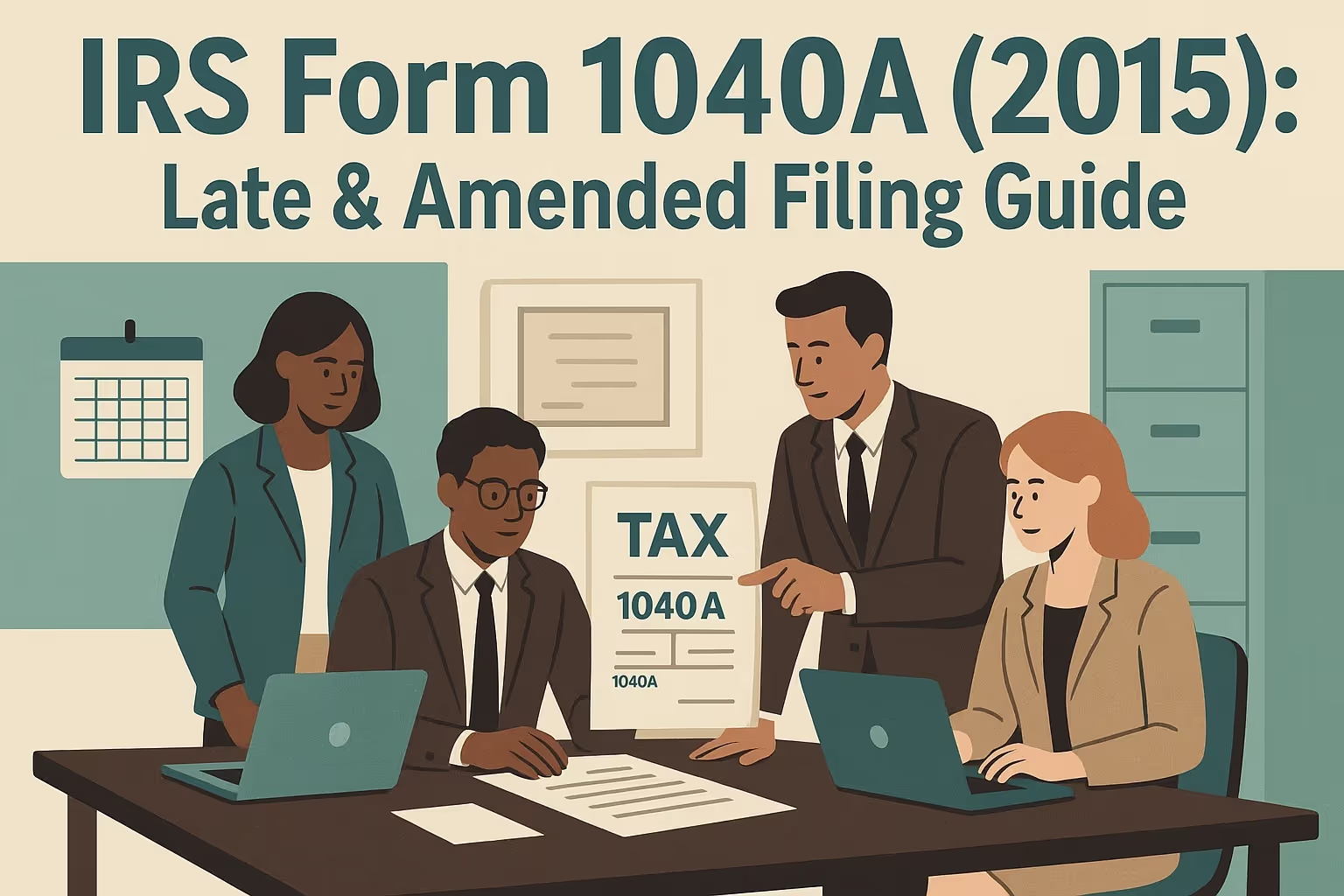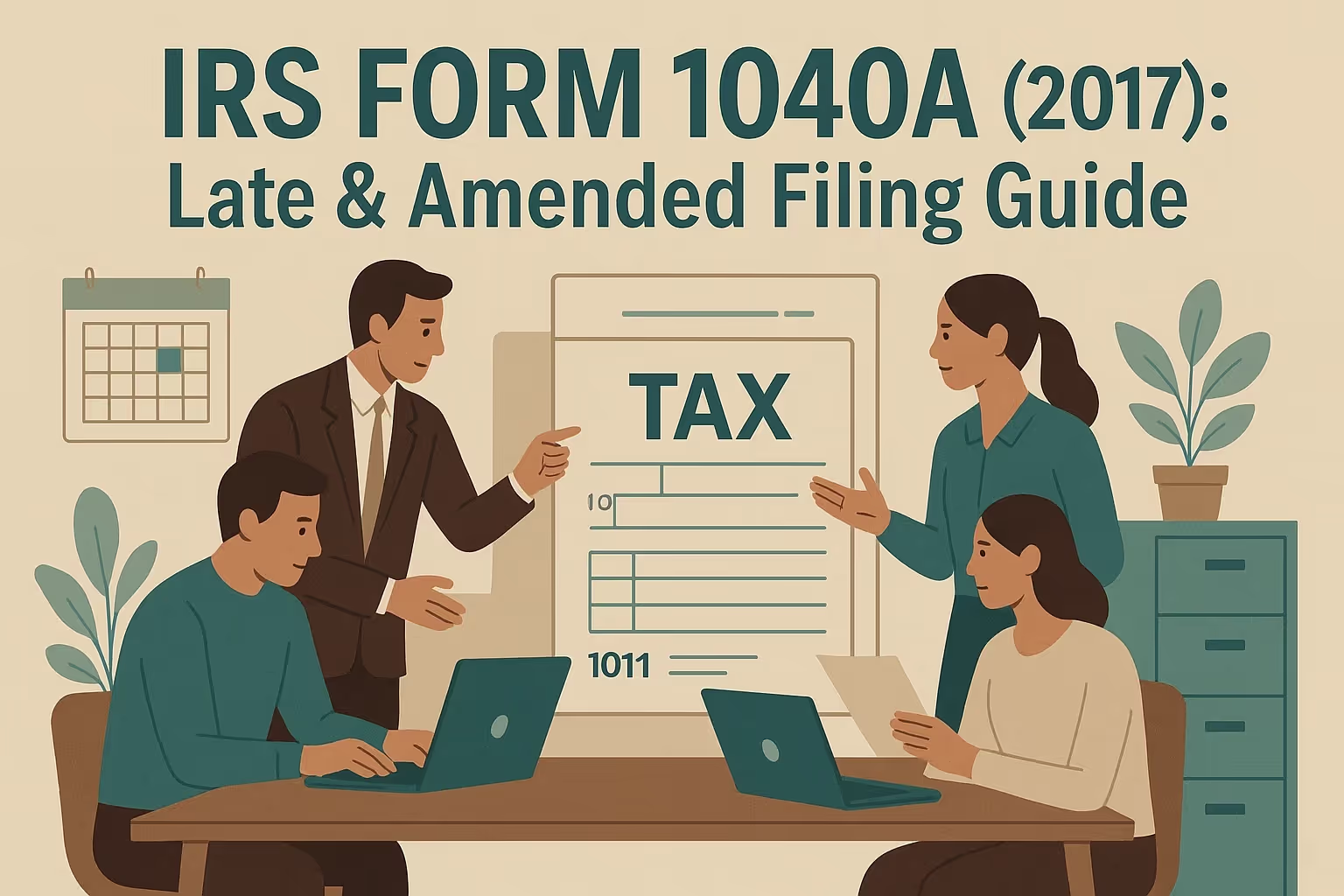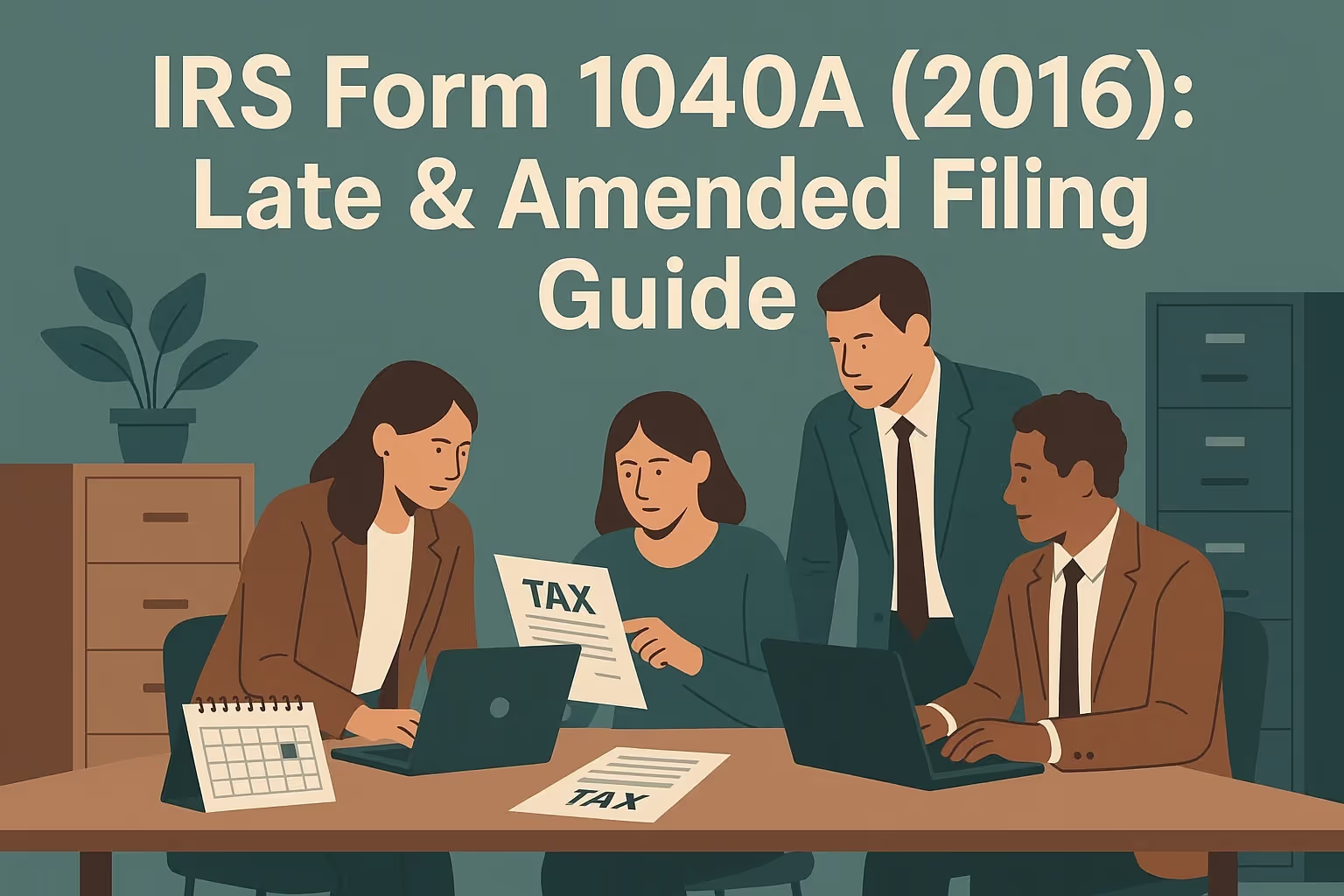
Filing a tax return is a required process for taxpayers each year, but the complexity of forms often depends on income types and deductions claimed. For the 2016 tax year, many individuals chose Form 1040A, an IRS form designed for simple tax filing. It offered more coverage than the 1040EZ while remaining easier than the complex Form 1040.
Form 1040A allowed taxpayers to report wages, interest, retirement distributions, and unemployment benefits while claiming valuable credits and deductions. It benefited families with a child or an elderly dependent who needed to qualify for specific tax benefits. Although discontinued after 2017, this form still applies for amended or late-filed returns, allowing taxpayers to address missed deadlines or incorporate updated documents.
This guide explains step-by-step instructions for Form 1040A 2016 in detail. You will learn to choose the right filing status, prepare forms, claim credits, and calculate adjusted gross income. It also covers how to e-file, pay taxes online, track a refund, and use software or expert help. With accurate information and free guidance, taxpayers can file easily today, avoid mistakes, and aim for the maximum refund possible.
Understanding Form 1040A
Form 1040A acted as an intermediate IRS form, bridging the gap between the simplest tax return option and the more detailed filing requirements of Form 1040. Taxpayers could claim the child tax credit, education credits, and earned income credit, which reduced their income tax and maximized refund opportunities. Form 1040A supported refunds were deposited directly into a bank account, giving taxpayers a faster and safer option when they chose to e-file.
Who can use Form 1040A
- Income limits: Taxpayers could file Form 1040A if their taxable income was below $100,000 and they did not require complex deductions or business reporting.
- Filing status flexibility: The form allowed all filing status categories, letting taxpayers choose single, married, or head of household options that reduced income tax liability.
- Covered situations: Individuals with wages, interest, Social Security benefits, or retirement distributions could use the form without meeting complicated filing requirements.
What changed for the tax year 2016
- Deadline shift: The filing deadline moved to April 18, 2017, due to Emancipation Day, giving all taxpayers additional time to file.
- Health coverage reporting: The Affordable Care Act rules continued, requiring taxpayers to confirm they were covered, pay penalties, or file exemptions for uncovered months.
- PIN elimination: The Internal Revenue Service removed the Electronic Filing PIN system, requiring taxpayers to use adjusted gross income from the prior year for identity verification.
- Refund delays: To allow extra review, refunds for taxpayers claiming the earned income credit or additional child tax credit were delayed until mid-February.
Eligibility Checklist
Taxpayers had to meet specific requirements to use Form 1040A for tax filing in 2016. The checklist below outlines the conditions clearly.
Income sources allowed on Form 1040A
- Wages and salaries: Employment income reported on Form W-2 could be included directly, making it simple for taxpayers to file without complex supporting schedules.
- Investment income: Interest, dividends, and capital gain distributions allowed taxpayers to report investment earnings without switching to a more extended return.
- Retirement and benefits: On Form 1040A, pensions, annuities, IRA distributions, unemployment compensation, and taxable Social Security benefits were the income types covered.
Adjustments (above-the-line deductions) you can claim
- IRA deduction: Contributions to a traditional IRA were deductible, reducing adjusted gross income and helping taxpayers qualify for certain credits or lower their tax liability.
- Student loan interest: Interest paid on qualified student loans could be deducted, lowering taxable income and offering financial relief for individuals still repaying education costs.
- Educator expenses: Eligible teachers could deduct limited classroom expenses, ensuring they received tax relief for money spent directly on supplies to support their job.
- Tuition and fees: Qualified higher education expenses could be deducted, helping taxpayers or dependents reduce adjusted gross income and potentially qualify for education-related tax credits.
Situations that disqualify you from using Form 1040A
- Self-employment income: Taxpayers earning $400 or more in self-employment income were required to file Form 1040 with Schedule SE to report their earnings accurately.
- Itemized deductions: Individuals who wanted to claim deductions for mortgage interest, property taxes, or medical expenses needed to use the longer Form 1040.
- Foreign earnings: Taxpayers with foreign income, assets, or accounts did not qualify to use Form 1040A because additional disclosures were required.
- Alternative minimum tax: Anyone subject to AMT or using specialized tax credits outside those covered by Form 1040A had to file a standard Form 1040.
Documents to Gather Before You File
Having the correct docs ready ensured accuracy and made the filing process easier. Collecting personal information, income statements, and coverage records was an essential first step.
Identification and personal records
- Social Security cards: These are required for taxpayers, spouses, and dependents to verify eligibility for credits and confirm the accuracy of tax filing information.
- Prior return copy: This helped enter prior-year adjusted gross income, which was needed when signing electronically and verifying identity for an e-file.
- Bank account details: These details are necessary for direct deposit, which ensures refunds arrive quickly and securely without delays linked to mailed paper checks.
Income statements and health coverage documents
- Form W-2: This form is used to report wages, salaries, and taxes withheld from employers. Every taxpayer who worked during the year must include this form.
- Form 1099: This form covers interest, dividends, retirement distributions, and unemployment income received. These forms were necessary to report investment and benefit income accurately.
- Form 1095: This form provides evidence of health coverage for each household member. It confirmed compliance with ACA rules or allowed exemptions for uncovered periods.
- Credit support forms: These include Form 1098-E for student loan interest and other IRS forms supporting claims for deductions and credits on the tax return.
Step-by-Step Instructions for Filing Your Income Tax Return
Completing Form 1040A requires accuracy and attention to detail. Following each step in sequence helped taxpayers avoid mistakes and ensured compliance with IRS rules.
Step 1: Complete personal information and choose your filing status
Start by providing your name, address, and Social Security number. Select the correct filing status—single, married, head of household, or qualifying widow(er). Filing status determines standard deductions, credits, and refund eligibility. Errors at this stage could delay processing or reduce accuracy, so review details carefully before signing or uploading your completed tax return.
Step 2: Claim exemptions and list dependents
Enter exemption details for yourself, your spouse, and qualifying dependents. Dependents may include children or relatives meeting IRS guidelines for support and residency. Listing dependents properly allows taxpayers to claim essential credits such as the child tax credit. Ensure Social Security numbers are accurate and confirm eligibility rules to prevent e-file rejection.
Step 3: Report income: wages, interest, dividends, benefits, distributions
Include all income types, such as wages from Form W-2, interest from Form 1099-INT, and retirement distributions from Form 1099-R. Unemployment compensation and Social Security benefits were also reported here. Accurately recording income ensures your adjusted gross income is correct, which affects eligibility for credits, deductions, and whether you qualify for a refund or owe taxes.
Step 4: Calculate adjustments and determine AGI
Enter allowable adjustments, including IRA contributions, student loan interest, educator expenses, and tuition deductions. Subtract these adjustments from total income to determine your adjusted gross income (AGI). This figure is central to the tax return process. It determines credit qualification, phase-out limits, and overall income tax liability. Errors here can affect eligibility for valuable deductions and credits.
Step 5: Standard deduction, exemptions, and tax calculation
Apply the standard deduction based on your filing status and age. Add exemptions for yourself, spouse, and dependents, then calculate taxable income. Using the IRS tax tables, compute tax owed. For 2016, Form 1040A filers could not itemize deductions. Ensuring accuracy in this step helps taxpayers meet compliance and avoid penalties while maximizing opportunities for a larger refund.
Step 6: Claim credits for max refund: education, child-related, retirement savings, elderly/disabled
List applicable credits, including the child tax credit, American Opportunity Credit, Lifetime Learning Credit, and the retirement savings contributions credit. Eligible elderly or disabled taxpayers could also claim additional credits. Credits directly reduce the amount of tax owed, unlike deductions, which only reduce taxable income. Correctly claiming credits improves refund size and provides financial relief for qualifying taxpayers.
Step 7: Health coverage checkbox and final tax after credits
Confirm health coverage for your spouse and dependents by checking the full-year coverage box. If coverage was missing, calculate penalties or claim exemptions using IRS forms. After reporting coverage, determine the total tax owed by subtracting credits from the preliminary tax liability. This step finalizes your tax before accounting for payments already made through withholding or estimated payments.
Step 8: Payments, refundable credits, refunds, or amounts owed
Report all federal tax withheld from W-2 and 1099 forms and refundable credits like the Earned Income Credit. Compare payments and credits against the final tax owed. If total payments exceed liability, you qualify for a refund. If liability exceeds payments, you owe money to the IRS and must arrange payment before the deadline.
How to File: E-File vs. Paper
After completing the form, taxpayers must choose whether to file electronically or mail a paper return. Each method had distinct advantages.
File Taxes Online
- Faster refunds: E-filing ensured quicker processing and faster refunds, often arriving within 21 days when combined with direct deposit into bank accounts.
- Signature validation: Since the PIN system was eliminated, taxpayers had to enter prior-year adjusted gross income to confirm identity and acknowledge the return.
- Error reduction: Tax software flagged common mistakes, missed credits, or inaccurate entries, improving accuracy compared to handwritten forms and manual calculations.
- Secure submission: Data uploaded directly from the taxpayer’s device to the IRS was encrypted, making electronic tax filing safer than mailing paper documents.
- Free access: The IRS Free File service allows eligible taxpayers with lower adjusted gross income to prepare and file electronically at no cost.
Paper filing
- Ink requirement: For proper IRS processing, paper returns had to be completed using black or blue ink with clear block letters.
- Signature rules: Returns require signatures from the taxpayer and spouse if filing jointly, and unsigned returns are automatically rejected or considered incomplete.
- Mailing locations: Addresses varied depending on state and refund status, requiring taxpayers to choose the correct IRS service center for submission.
- Attachments required: Copies of all W-2s and 1099-Rs with withheld taxes must be attached directly to the front of the return.
- Processing speed: Refunds for paper returns generally took 6–8 weeks, significantly longer than electronic filings with direct deposit options.
Paying Your Balance
If Form 1040A showed a balance owed, taxpayers had to pay the IRS by the deadline to avoid penalties and interest charges.
Electronic and traditional payment options
- IRS Direct Pay: This service allows free same-day transfers from checking accounts, ensuring money reaches the IRS on time without additional service fees.
- EFTPS system: The Electronic Federal Tax Payment System enabled scheduled payments up to a year in advance, helping taxpayers manage obligations efficiently.
- Credit or debit cards: Payments could be made using cards through IRS-approved processors, though taxpayers incurred a percentage-based convenience fee.
- Check or money order: Taxpayers could send payments by mail, making checks payable to “United States Treasury” and writing identifying details on the memo line.
- Cash payments: A limited option allowed payments at participating retailers for a small fee, with strict daily and yearly limits on amounts paid.
Installment agreement
- Short-term plans: Taxpayers owing smaller balances could request full payment for up to 120 days, though interest would continue until the balance was resolved.
- Long-term plans: Installment agreements allowed monthly payments for larger balances under $50,000, providing flexibility to manage money without immediate full payment.
Key deadlines, penalty types, and how to avoid extra costs
- Filing deadline: For 2016 returns, the deadline was April 18, 2017, with penalties applying if taxpayers failed to file on or before this date.
- Failure-to-file penalty: This penalty equaled 5% of the unpaid monthly tax, up to 25%, making late filing highly costly to taxpayers.
- Failure-to-pay penalty: This penalty is charged at 0.5% per month on unpaid balances, with lower rates applied if installment agreements were established with the IRS.
- Interest charges: Daily compounded interest applied to unpaid taxes and penalties, increasing overall balances the longer they remain unresolved.
- Avoiding costs: Taxpayers could avoid penalties by filing on time, paying as much as possible, and arranging payment plans if unable to pay in full.
Required Schedules and Attachments
Some taxpayers needed to include schedules or extra forms when filing Form 1040A. Attaching the proper documents helped ensure the return was processed correctly.
Items you always attach
- Form W-2: Employers provided this form showing wages and taxes withheld. It had to be attached for each job held during the tax year.
- Form 1099-R: Taxpayers who received retirement distributions with federal taxes withheld had to include this form, ensuring accurate reporting and credit for payments made.
Attach Schedules and IRS forms
- Schedule B: This schedule is required if taxable interest or dividends exceeded $1,500, or if taxpayers had certain foreign accounts or trusts needing disclosure.
- Schedule EIC: This schedule is needed when claiming the earned income credit with qualifying children. It requires details such as age, residency, and Social Security numbers.
- Form 8863: This form is used to claim education credits such as the American Opportunity Credit or Lifetime Learning Credit, and it requires documentation of tuition paid.
- Form 8880: This form helps in claiming the retirement savings contributions credit, providing benefits to eligible taxpayers who contributed to qualifying retirement accounts.
- Form 2441: This form is required for claiming the child and dependent care credit. It lists the expenses paid and the provider’s information to verify eligibility.
Attachment order, stapling, and record-keeping tips
- Order required: Place Form 1040A first, followed by schedules and supporting forms in numerical order, with W-2s and 1099-Rs attached to the front.
- Stapling rules: Attach documents only to the upper left corner to prevent issues when the IRS staff scans and processes the return electronically.
- Record keeping: Always keep copies of all submitted forms, schedules, and attachments to provide documentation for future questions or audits
Common Errors and How to Avoid Them
Mistakes often slowed processing or triggered IRS notices. Knowing the most frequent issues helped taxpayers file accurately and avoid unnecessary delays.
Identity, SSN, and filing status mistakes
- Incorrect numbers: Many returns were rejected due to errors in the Social Security numbers of taxpayers, spouses, or dependents listed on the form.
- Wrong filing status: Taxpayers select the incorrect option, such as claiming head of household without qualifying, changing tax liability, and delaying refunds.
Math errors and tax table lookups
- Calculation errors: Adding or subtracting incorrectly, or using the wrong tax table entry, often lead to changes in results and force the IRS to adjust.
- Rounding issues: Some amounts need to be rounded to the nearest whole dollar. Inconsistent rounding created mismatches that delayed refund processing.
Direct deposit details and e-file rejection fixes
- Banking mistakes: Refunds were delayed or misdirected when taxpayers entered incorrect routing or account numbers for direct deposit.
- E-file rejections: Submissions were often rejected due to mismatched prior-year AGI, requiring taxpayers to confirm details and resubmit electronically
Zero-Activity or Low-Income Situations
Not everyone needed to file Form 1040A in 2016, but in some cases, filing still brought advantages, such as receiving a refund or claiming credits.
When you do not need to file a 2016 return
- Income below thresholds: If total income did not exceed IRS filing limits for the year, taxpayers were not required to file.
- No withholding or credits: Taxpayers with little or no tax withheld and no refundable credits available did not benefit from submitting a return.
When you should file anyway to claim a refund or credit
- Withheld taxes: Filing allows taxpayers to recover federal income tax withheld from wages, even if their income was below the filing threshold.
- Refundable credits: Claiming earned income credit or additional child tax credit often results in a refund, even for households with very low incomes.
First-Time Filer Strategies
Filing taxes for the first time can be challenging, but simple preparation steps can help taxpayers avoid mistakes and complete returns accurately.
Strategy For Your First Return
- Start with basics: Gather W-2s, 1099s, and identification documents early to avoid missing information that could slow preparation and filing.
- Choose e-file: Filing taxes online using IRS-approved software increased accuracy, reduced mistakes, and ensured refunds arrived faster through direct deposit.
Consider Seeking Tax Expert Help
- VITA program: Volunteer Income Tax Assistance offers free guidance for qualified taxpayers, providing expert help for completing returns correctly.
- Recordkeeping habit: Keeping copies of forms and documents for at least three years ensured accuracy if questions arose or adjustments were required later.
After You File: Tracking and Recordkeeping
After submitting the return, taxpayers must monitor refund progress and keep records for future reference. These steps prevent problems later.
- Track refund: Taxpayers should use the IRS “Where’s My Refund?” service online to check refund status. Respond immediately to any notices received to prevent unnecessary delays.
- Respond quickly: IRS notices often require clarification or documentation. Acting quickly avoids penalties, ensures accuracy, and helps taxpayers resolve issues without escalation.
- Maintain records: Keep a full copy of the return, schedules, and supporting docs. Proper recordkeeping protects taxpayers during audits and supports amended filing if needed.
- Retention period: The IRS recommends keeping records for at least three years. However, if taxpayers claim losses or report foreign income, more extended storage may be required.
Frequently Asked Questions
What is the difference between Form 1040A and Form 1040 for 2016?
Form 1040A was a simplified two-page tax return suitable for straightforward income types, while Form 1040 supported complex situations like itemized deductions and business reporting. Taxpayers with only wages, interest, dividends, and retirement benefits could qualify for Form 1040A. Those with higher incomes or complex deductions needed Form 1040 to ensure complete tax filing accuracy.
Can married taxpayers use Form 1040A, and which tax filing status usually saves more?
Yes, married taxpayers could file Form 1040A jointly or separately. Filing jointly generally provides a higher standard deduction and better refund opportunities by combining income types and deductions on one return. Married filing separately was sometimes chosen to separate liability or manage unique financial circumstances, though it usually resulted in higher taxes owed compared to joint filing.
Do I need to report small amounts of bank interest and dividends on Form 1040A?
Yes, all taxable bank interest and dividends had to be reported on Form 1040A, regardless of dollar amount. Even small amounts contributed to adjusted gross income and affected overall tax liability. While Schedule B was only required if interest or dividends exceeded $1,500, smaller amounts still had to be listed to maintain accuracy and avoid future IRS notices.
How do the American Opportunity Credit and Lifetime Learning Credit work with Form 1040A?
Form 1040A supported the American Opportunity Credit and the Lifetime Learning Credit, which were claimed by attaching Form 8863. These credits directly reduced tax liability and sometimes produced a refund. Eligibility depended on qualified tuition or education expenses paid during the year. Filing with supporting documentation ensured compliance, improved accuracy, and allowed taxpayers to maximize education benefits on their return.
What if I did not have health coverage for all of 2016—do I owe a payment or qualify for an exemption?
Taxpayers without full-year health coverage had to calculate a shared responsibility payment or claim exemptions using Form 8965. Certain exemptions applied for financial hardship, short gaps in coverage, or other exceptional circumstances. Filing correctly ensured compliance with Affordable Care Act requirements. Accuracy at this step prevented penalties, avoided processing delays, and protected refund eligibility for the 2016 tax year.
My return was e-filed and rejected. What should I check, and how do I resubmit?
If your e-filed return was rejected, confirm that prior-year adjusted gross income, Social Security numbers, and dependent information match IRS records. Correcting errors and resubmitting electronically often resolved issues. If rejection persists or the deadline approaches, mailing a paper return ensures compliance. Accurate entries and timely action helped taxpayers avoid penalties and ensured smooth IRS acceptance of the return.


























